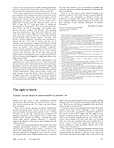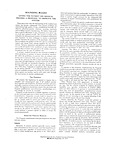Cross-posted, with prolog, from the blog of Ted Eytan MD.
Yesterday the Institute for Healthcare Improvement’s “WIHI” series hosted a terrific webcast on the Open Notes project that’s being funded by the Robert Wood Johnson Foundation. (I need to dig up the link to the event’s archive, but I’m in a hurry.)
Speakers were Dr. Tom Delbanco of Beth Israel Deaconess Medical Center (a pioneer of patient access), Dr. Mary Merkel of Dartmouth-Hitchcock, and Bob Desaulniers, a patient of Dr. Merkel’s who lives in my own town, Nashua NH. Gotta go meet them!
Inevitably we revisited the hoary concerns about the horrible things that will happen if we see our health data. Dr. Delbanco cited a paper from the 1970s that advocated giving patients their medical records. And this morning Ted Eytan dug it out.
In this era of evidence-based medicine, isn’t it time for policy makers to look at this evidence?
Ted’s post:
________________________________________
 McLaren P. The right to know. [Internet]. BMJ 1991;303(6808):937-938.
McLaren P. The right to know. [Internet]. BMJ 1991;303(6808):937-938.
I’m not that smart and my ideas are not that unique.
This is why I enjoy writing the posts that are tagged “where we came from” on this blog.
The title of this one comes from a 1991 article published in the British Medical Journal about the idea of providing patients access to their complete medical record. To really dig deep, though, I wanted to grab the seminal 1973 article from The New England Journal of Medicine on this topic, and thanks to the Internet, I found it.
In Sounding board. Giving the patient his medical record: a proposal to improve the system (There appears to be a PDF of this article on the Internet here), authors Shenkin and Warner lay out some facts about the health system that don’t seem to different than those of today, sadly:
Dissatisfaction with the functioning of the medical care-system has become widespread. Four serious problems are maintaining high quality of care, establishing mutually satisfactory physician-patient relations, ensuring continuity and avoiding excessive bureaucracy.
Some differences were apparent in 1973, such as the fact that in 41 states, patients could only obtain their medical records through litigation (!). Also, it appears with the emergence of “centralized organization” though things like health maintenance organizations, that physician autonomy was under siege. The health system was considered at the time to be “decentralized to the penultimate step – the physician” and the fear was that their autonomy was “unchecked.”
All of that aside, the authors, quite visionary in my opinion, laid out an almost Web 2.0 version of the medical world.
They talked about the idea of “decentralized medical review.” A few quotes:
The freely available record would provide a more “longitudinal” view of a patient, and physicians would appreciate better (and treat better) the course of a disease. Since innovation proceeds mainly by the contagion effect, new knowledge would probably be put into practice more swiftly.
And this one
Decentralized peer review would provide recognition of excellence in the practice of medicine, and hence enhance the prestige of being a practicing physician. Patient records and the care that they reflected would become a source of pride open to the perusal of fellow professionals. The expected improvement in continuity would decrease frustrations, and improved physician-patient relations would add importantly to physician satisfaction.
Whoa. They are talking wisdom of crowds, viral innovation, and building trust through transparency. In 1973.
Flash forward to 1991. In The Right to Know, author McLaren discusses data from Denmark, which provided patients “statutory rights” to their entire hospital record, with no ill effects. He concludes:
The argument against giving patients greater access to their records has been lost; the challenge now is to get doctors skilled in writing records that their patients will find useful.
Whoa. He’s talking Meaningful Use.
1973 was before my medical time, but 1991 wasn’t. In 1991 I was in medical school, and I’m pretty sure if you asked me, “Ted, should your patients see what you wrote about them in that manila folder thing with paper?” I would have said, “Why shouldn’t they?”
Ironically, it’s probably the very group that opposed these viewpoints that are responsible for creating mine. Summer of 1991 was my first (and I think just one of 2) trips to the national meeting of the American Medical Association, in Chicago. That meeting was marked by protests from the HIV/AIDS community on the outside. And on the inside, after a week, I remember leaving with the thoughts, “I met a lot of great peers here, but who are these leaders who are resistant to technology and only allow heterosexual men to participate?* They aren’t me. And I’m not them.” This is the heritage of Generation X – we were groomed to be on the side of the patients.
So that’s my story, and the story of where we came from with regard to sharing medical records with patients. Has nothing happened in 18 years? Absolutely not.
- The largest medical groups in the United States regularly share medical records with patients, online
- Most patients have a “statutory right” to their hospital record, albeit, not in the most friendly or useful way (see this example from Tufts University)
- Crowdsourcing, trustbuilding, and transparency are sweeping the business world. Health care is on the verge.
- Generation X are the attending physicians and medical directors, Generation Y are graduating from their residencies.
In the Shenkin article, it was proposed that a law be passed to require that a “complete and unexpurgated copy of all medical records, both inpatient and outpatient, be issued routinely and automatically to patients as soon as the services provided are received.” They do a great job of covering every known objection, “firstly” through “ninthly.”
My favorite is of the fear of “poor quality review” by peers and patients. They said that in 1973, it is “safer for them (physicians) to measure adequacy by academic degrees achieved than by competence demonstrated.”
The great thing I have learned pretty solidly from so many people by 2009 is that the medical community has so much support from patients and families – they want them to be great, they will only help. One patient said this at a recent continuing education course to room of us: “Can I just say thank you for paying attention in medical school, you are in my thoughts, you have my full gratitude.”
Let’s please remember these words to keep the conversation about ending secrecy an easy one, not a hard one. And, carry these two articles in our back pockets at all times.
*The American Medical Association has since reversed its stance on discriminating against gay, lesbian, bisexual and transgender physicians and patients.







In the same vein, the Cochrane review titled, Giving women their own case notes to carry in pregnancy included 3 trials, 2 of which were published in 1987. The third was published in 1999. These are not new ideas!
Just realized the irony – the babies of some of those women who carried their own records may now be having babies of their own and no timely access to their health data. Now that’s sad.